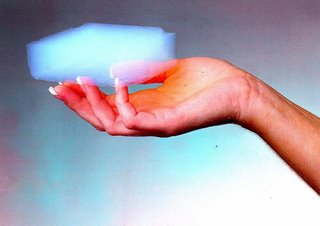The first time I saw this thing is couple of years ago on TV. They demonstrated it is almost able to float in air and be shaped by your own hands, but it's somehow still solid. How could this happen in reality? It seems you could only see this kind of material in science fiction!
Aerogel, in which 99.8 percent of the volume is empty space, is only about 3 times denser than air. Many people may speculate that aerogel is the recent product of most modern technology. In fact, the first aerogel was produced in 1931 by Steven. S. Kistler in Stanford University. The newest one is lighter than the 1930's version by NASA and it has been recognized by Guinness World Records as the solid with the lowest density.
 The ideal of the structure is very simple, removing the liquid from the wet gel without damaging the solid component. Like gelatin, after mixing liquid silicon compound and a fast-evaporating liquid solvent, the gel is dried in a "pressure cooker" and then heating and reducing pressure produces glass-like sponge of silicon. Regarding as a silicon-based solid with porous, it is a new member of glasses family.
The ideal of the structure is very simple, removing the liquid from the wet gel without damaging the solid component. Like gelatin, after mixing liquid silicon compound and a fast-evaporating liquid solvent, the gel is dried in a "pressure cooker" and then heating and reducing pressure produces glass-like sponge of silicon. Regarding as a silicon-based solid with porous, it is a new member of glasses family.
"Obviously, if one wishes to produce an aerogel, he must replace the liquid with air by some means in which the surface of the liquid is never permitted to recede within the gel. If a liquid is held under pressure always greater than the vapor pressure, and the temperature is raised, it will be transformed at the critical temperature into a gas without two phases having been present at any time."
(S. S. Kistler, J. Phys. Chem. 34, 52, 1932)
Surprisingly, this seemingly brittle material support up to 1000 times its own weight and efficiently absorbing kinetic energy. Because of its large internal surface area, aerogel also provides 39 times insulating than the best fiberglass insulator. And many other unusual properties.
At present, aerogel is applied in experiments by NASA. One is the famous 2003 Mars Exploration Rover, which Spirit and Opportunity are under their exploring missions on Mars right now. Another is called Stardust. As a collector faced toward Comet Wild 2, aerogel will capture hypervelocity particles from Space. In future, It could be used for computer chips, which may reinvent what we call "processing speed"
Reference:
- Jet Propulsion Laboratory, NASA http://stardust.jpl.nasa.gov/tech/aerogel.html
- The Microstructured Materials Group, Lawrence Berkeley National Laboratory http://eande.lbl.gov/ECS/aerogels/aerogels.htm
No comments:
Post a Comment